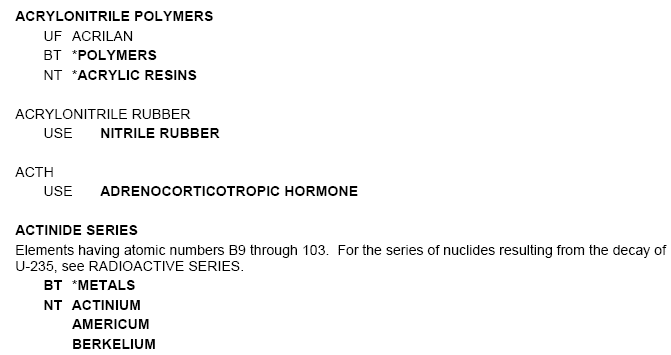Example 133: Equivalence relationship display

Source: DTIC Thesaurus
5.1 General Considerations | 5.2 Presentation of Relationships | 5.3 Types of Displays
USE references from non-preferred terms should be incorporated into the main listing of a controlled vocabulary rather than being relegated to an auxiliary “access vocabulary” or separate list of entry terms.
• USE (U) equivalence relationships should be created to lead users from entry vocabulary terms
to the preferred term.
• USED FOR (UF) equivalence relationships should be created to show users what synonyms and
near-synonyms are covered by the preferred term.
Example 133: Equivalence relationship display
Source: DTIC Thesaurus
5.2.2.1 Term Detail Presentation
When hierarchical and associative relationships have been established for a vocabulary, each term display should include some or all of the following information about the term, preferably in this order:
a) Scope notes
b) USE references
c) USED FOR (UF) references
d) Broader Term (BT) references to terms that are one level broader
e) Narrower Term (NT) references to terms that are one level narrower
f) Related Term (RT) references to terms that have an associative relationship with the term5.2.2.2 Narrower Terms
If there are multiple Narrower Terms, they are generally arranged alphabetically. They may also be arranged logically if another order would be more intuitive for the user: Indentation or other cues to the hierarchy are essential if more than one level of hierarchy is presented.
Example 137: Alphabetical arrangement of Narrower Terms
Example 138: Logical arrangement of Narrower Terms
5.2.2.3 Node Labels
Node labels may also be used to group both narrower and related terms in categories. Node labels in hierarchies, which are not to be used in indexing or searching, should be distinguished from terms, e.g., by placing them in square brackets.
Example 139: Node label display
Indentation should be used as an additional visual cue for hierarchical and associative relationship layouts.
Example 140: Use of indentation with relationship display
Terms, non-preferred terms, relationship indicators, and textual notes should be typographically
distinguished. Such distinctions are more important for certain types of displays, such as hierarchical,
or for certain formats, particularly print. Additional typographic distinctions may be needed for
electronic and Web formats to indicate hyperlinks. (See Z39.19 section 9.4.3.4.)
Suggested typographic specifications are:
• lightface or italics for non-preferred terms and notes,
• all capitals for relationship indicators such as USE, and
• boldface for terms.Example 141: Use of typographics in term display
teenagers USE adolescents
The controlled vocabulary should serve as an orthographic authority in addition to noting preferred terminology. A combination of capitals and lowercase letters should therefore be used in controlled vocabulary terms as dictated by usage. See Z39.19 section 6.7.1 for specific guidelines on capitalization.
This section provides general rules for the filing and sorting of alphabetic characters and numerals in controlled vocabularies. Resources such as the ALA Filing Rules [21], Library of Congress Filing Rules [29], and British Standard Alphabetical Arrangement and the Filing Order of Numerals and Symbols (BS 1749) [26] contain rules and guidelines for handling specific filing problems. These filing codes are, however, not compatible with each other in certain details, and only one of them should be chosen as an authority.
In electronic systems, sorting rules and handling of non-alphabetic characters may be preestablished by the software. Some systems provide options for developers to select the sorting rules. Where such options exist, the recommendations in this Standard should be selected.
Terms consisting of letters should be filed word-by-word rather than letter-by-letter.
In word-by-word filing, a space is significant. This filing principle is called “nothing before something.”
It keeps together terms that begin with the same word.
Example 142: Comparison of word-by-word and letter-by-letter filing
| Table of Contents |
| 1. Why Vocabulary Control | 2. Principles | 3. Structures | 4. Semantic Relationships |
| 5. Displays | 6. When to use | 7. Examples of use | 8. About Z39.19 |
©NISO, 2005 http://www.niso.org/
Source: Based on ANSI/NISO Z39.19-2005 ISBN: 1-880124-65-3
Guidelines for the Construction, Format, and Management of Monolingual Controlled Vocabularies